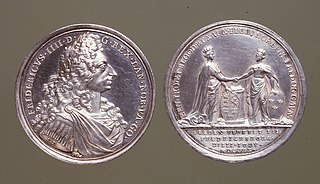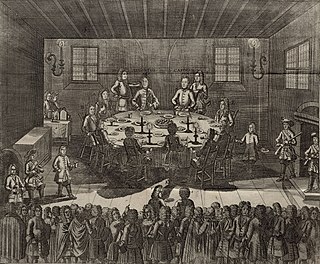Related Research Articles

The Treaty of Roskilde was negotiated at Høje Taastrup Church and signed (NS) during the Second Northern War between Frederick III of Denmark–Norway and Karl X Gustav of Sweden in the Danish city of Roskilde. After a devastating defeat, Denmark–Norway was forced to give up a third of its territory to save the rest, the ceded lands comprising Blekinge, Bornholm, Bohuslän (Båhuslen), Scania (Skåne) and Trøndelag, as well as her claims to Halland.

The Treaty or Peace of Oliva of 23 April (OS)/3 May (NS) 1660 was one of the peace treaties ending the Second Northern War (1655–1660). The Treaty of Oliva, the Treaty of Copenhagen in the same year, and the Treaty of Cardis in the following year marked the high point of the Swedish Empire.
The Treaties of Stockholm were two treaties signed in 1719 and 1720 that ended the war between Sweden and an alliance of Hanover and Prussia.

The Treaty of Bromberg or Treaty of Bydgoszcz was a treaty between John II Casimir of Poland and Elector Frederick William of Brandenburg-Prussia that was ratified at Bromberg (Bydgoszcz) on 6 November 1657. The treaty had several agreements, including the Treaty of Wehlau, signed on 19 September 1657 by the Brandenburg–Prussian and Polish–Lithuanian envoys in Wehlau. Thus, the Treaty of Bromberg is sometimes referred to as treaty of Wehlau-Bromberg or Treaty of Wehlau and Bromberg.

The Treaty of Frederiksborg was a treaty signed at Frederiksborg Castle, Zealand, on 3 July 1720, ending the Great Northern War between Denmark–Norway and Sweden.

The Treaty of Stettin of 13 December 1570, ended the Northern Seven Years' War fought between Sweden and Denmark with its internally fragmented alliance of Lübeck and Poland. It also settled Swedish, Danish, and Holy Roman Imperial claims regarding the Livonian War. Unfavourable for Sweden, the treaty assured Danish hegemony in Northern Europe for a short period. Yet, because of its inconclusiveness, it did not prevent further warfare between Denmark-Norway and Sweden, which ended only in the 1720s.

The Treaty of Labiau was a treaty signed between Frederick William I, Elector of Brandenburg and Charles X Gustav of Sweden on 10 November (O.S.) / 20 November (N.S.) 1656 in Labiau. With several concessions, the most important being the elevation of Frederick William I from a Swedish vassal to a full sovereign in the Duchy of Prussia and in Ermland, Charles X Gustav strove to "buy Frederick William's support" in the ongoing Second Northern War.

The Treaty of Preobrazhenskoye was negotiated by Johann Patkul and signed on 22 November 1699 in Preobrazhenskoye, a favoured residence of the tsar Peter the Great. It followed an informal meeting of Peter and Augustus at Rava in August 1698. The treaty called for the partition of the Swedish Empire among Denmark-Norway, Russia, Saxony and the Polish–Lithuanian Commonwealth. Following the treaty, the Great Northern War began.

The Peace of Travendal was a peace treaty concluded at the outset of the Great Northern War on 18 August 1700 between the Swedish Empire, Denmark–Norway and Holstein-Gottorp in Traventhal. Denmark had to return Holstein-Gottorp to its duke, a Swedish ally, and to leave the anti-Swedish alliance. The Danes only reentered the war after Sweden's major defeat in the Battle of Poltava, 1709, having used the time to reform their army. The treaty was guaranteed by France, the Holy Roman Empire, the United Provinces (Netherlands) and Great Britain.

The Treaty of Fontainebleau, signed on 23 August (O.S.) / 2 September 1679, ended hostilities between Denmark-Norway and the Swedish Empire in the Scanian War. Denmark, pressured by France, restored all conquests made during the war to Sweden in turn for a "paltry indemnity". The treaty was confirmed, detailed and amended in the subsequent Peace of Lund.
The Treaty of Narva was concluded on 19 August (O.S.) / 30 August 1704 during the Great Northern War. The faction of the Polish–Lithuanian Commonwealth loyal to Augustus the Strong joined the anti-Swedish alliance between the Saxon electorate and the Tsardom of Russia.
On 22 October 1709, during the Great Northern War, the alliance between the Russian Empire and Denmark-Norway was renewed in the Treaty of Copenhagen. Charles XII of Sweden had destroyed the previous alliance in Travendal (1700). For Russia, Vasily Lukich Dolgorukov signed the treaty in Copenhagen.

The Treaty of Altranstädt was concluded between Charles XII of Sweden and Augustus the Strong of Saxony and Poland–Lithuania, on 13 October 1706, during the Great Northern War. Augustus had to renounce his claims to the Polish throne and his alliance with Russia.
The Treaty of Hanover was concluded on 3 July 1710, during the Great Northern War. It allied the Russian Empire with Brunswick-Lüneburg (Hanover). Though Hanover was not among the most important states of the Holy Roman Empire, the alliance was important since the Hanoveranian duke, with whom the alliance was concluded, was subsequently to become king of Great Britain as George I.
The Treaty of Schwedt was concluded on 6 October 1713, during the Great Northern War, between the Tsardom of Russia and Brandenburg-Prussia in Schwedt. Brandenburg-Prussia was promised southern Swedish Pomerania up to the Peene river, which had just been conquered by Russia. In turn, Brandenburg-Prussia accepted Russia's annexation of Swedish Ingria, Estonia and Karelia, and agreed to pay 400,000 thalers to Russia. Southern Swedish Pomerania was to be administered by Brandenburg-Prussia until a definite ruling in a peace treaty was reached.
The Treaty of Greifswald was concluded on 28 October 1715, during the Great Northern War. George I of Great Britain and Elector of Hanover was assured Russian neutrality in his annexation of the Swedish dominion Bremen-Verden, on which he had agreed in the Treaty of Berlin. In turn, George I accepted Russia's annexation of Swedish Ingria, Estonia with Reval and Karelia.
The Treaty of Stettin was concluded on 28 April 1715, during the Great Northern War, in the Prussian camp at Stettin between Hanover and Prussia. The treaty allied George I of Great Britain, as Elector of Hanover, with the Kingdom of Prussia against the Swedish Empire. In the years following the establishment of this treaty, Sweden was forced out of it holdings south of the Baltic Sea, ultimately leading to Sweden's defeat in 1721, at the conclusion of the Great Northern War.
The Treaty of Dresden was concluded on 28 June 1709, during the Great Northern War. It re-established the alliance between Frederik IV of Denmark-Norway and Augustus the Strong against the Swedish Empire.
The Treaty of Elbing was signed between the Dutch Republic and the Swedish Empire on 1 September (OS) / 11 September 1656, during the Second Northern War, in Swedish-held Elbing (Elbląg). It served to protect Dutch interests in the Baltic Sea, ended the Dutch intervention in the Swedish siege of Danzig, and renewed a fragile peace between the Dutch Republic and Sweden. Within the former, there was opposition to the treaty demanding elucidations, which were agreed upon only on 29 November (OS) / 9 December 1659 in the Convention of Helsingör. Earlier in 1659, in the Concert of The Hague, England, France, and the Dutch Republic had agreed to include the treaty of Elbing in their common agenda regarding the Second Northern War.

The Treaties of Roskilde of 18 and 22 November 1568 were peace treaties between the kingdoms of Denmark–Norway and the allied Free and Hanseatic City of Lübeck on one side, and the Swedish kingdom on the other side, supposed to end the Northern Seven Years' War after the de facto succession of the later king John III of Sweden. Negotiated on John's initiative, he refused ratification, viewing the concessions his envoys made in Roskilde as too far-reaching. Most notably these concessions included Swedish obligations to pay Denmark–Norway her war costs and to cede Swedish Estonia. Thus, the war dragged on until it was concluded by the Treaty of Stettin (1570).
References
- ↑ Ward, Adolphis William (2008). Great Britain a Hanover. Some Aspects of the Personal Union (reprint ed.). BiblioBazaar, LLC. p. 87. ISBN 978-0-559-20427-2.
- 1 2 Buchholz, Werner, ed. (1999). Pommern (in German). Siedler. p. 343. ISBN 3-88680-780-0.